Word count: 3245. Estimated reading time: 16 minutes.
- Summary:
- The TV is a Philips 65OLED937 which What Hi-Fi? summarised in its review as ‘One of the most all-round spectacular TVs ever made’ (having used it for the past few days, I would concur). Originally retailing at a cool €3,500 in the EU, I got it for €2,300 in the Black Friday sales. The display is indeed very good. Not quite as good as my Samsung Galaxy S10 phone’s display which remains the best I’ve ever laid eyes upon personally, but no I really could not fault the LG OLED panel in that Philips TV.
Wednesday 6 December 2023: 01:15.
- Summary:
- The TV is a Philips 65OLED937 which What Hi-Fi? summarised in its review as ‘One of the most all-round spectacular TVs ever made’ (having used it for the past few days, I would concur). Originally retailing at a cool €3,500 in the EU, I got it for €2,300 in the Black Friday sales. The display is indeed very good. Not quite as good as my Samsung Galaxy S10 phone’s display which remains the best I’ve ever laid eyes upon personally, but no I really could not fault the LG OLED panel in that Philips TV.
Last post I said only some digger driving remained to complete the Lego concrete blocks to the rear of the site, and we got it done:
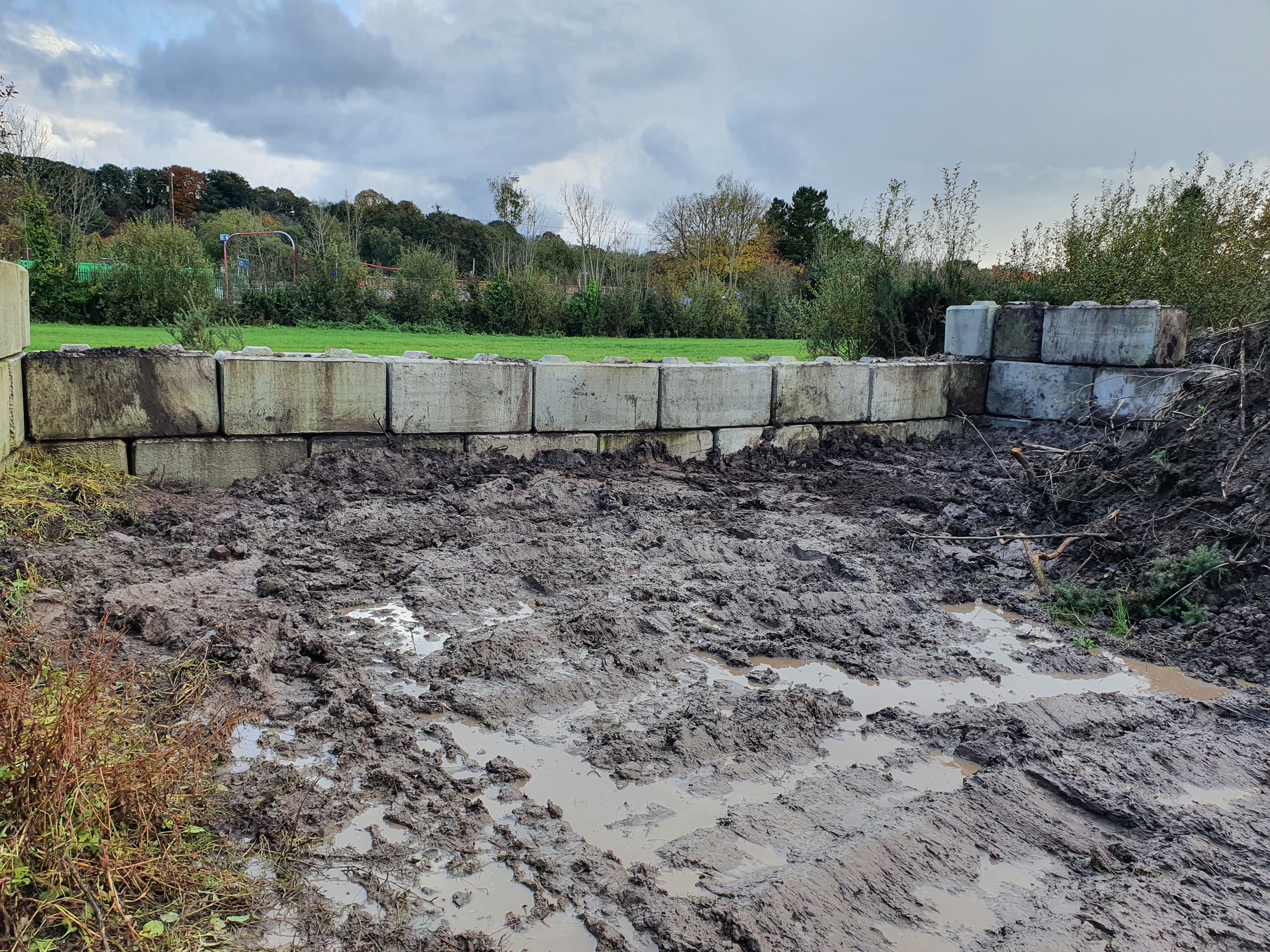
From the neighbour's wall laid in a previous long weekend looking at all new blocks laid
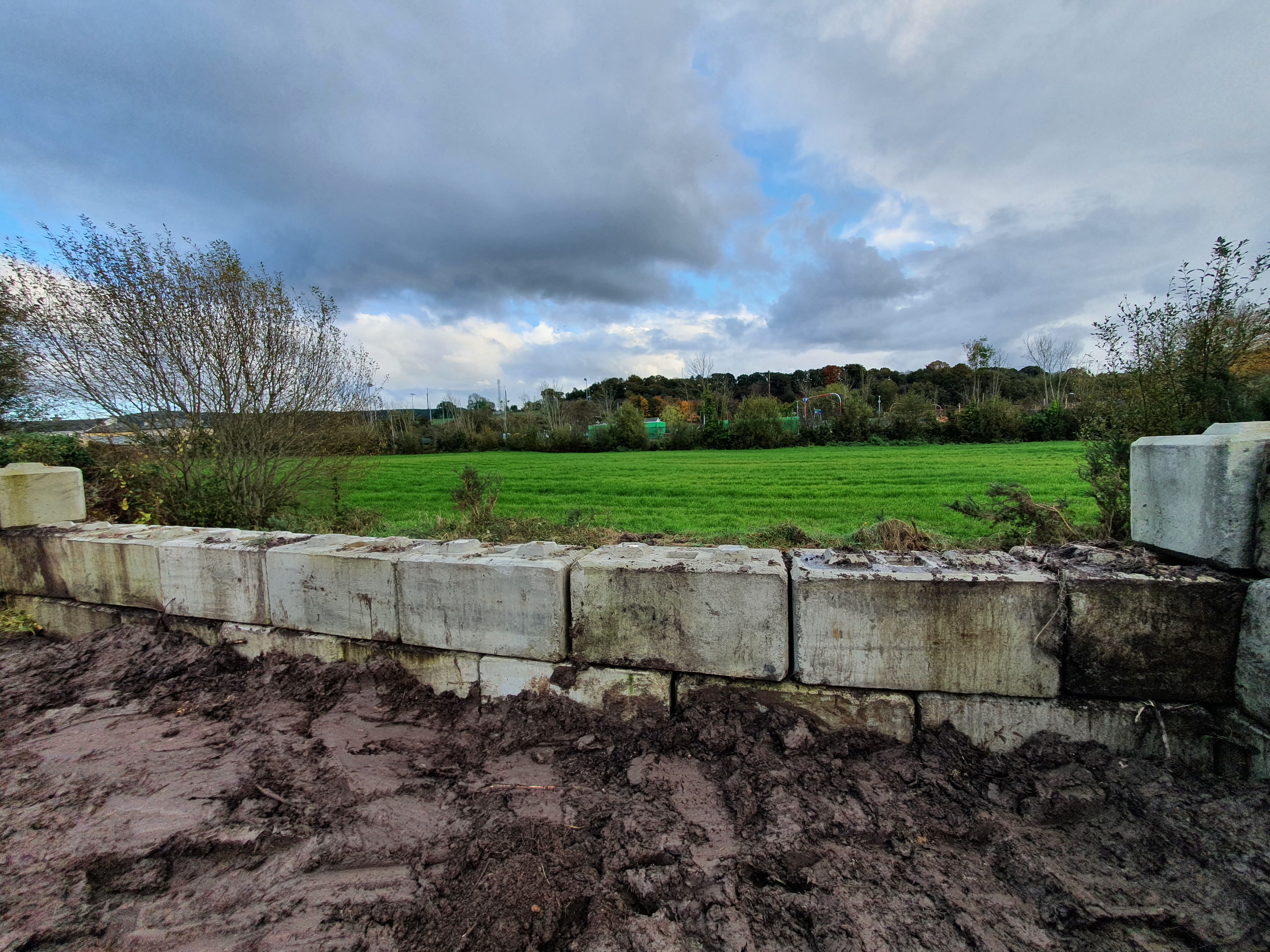
There is now a clear unobstructed view to the south to aid growing my future vegetables
As you can probably tell, the ground was absolutely saturated with recent rainfall and therefore the going was pretty tough as due to being on my own, every time you lay a block it requires leaving the digger cab twice, getting to the block and changing its shackles. This meant your boots sinking into a foot or more of tarry liquid soil, which was both slippy and exhausting. The weather itself held off that long weekend which was good, because we ended up needing all three days to get the work done, plus also laying pounded crushed rock foundations when it’s raining is rather counterproductive. And even then, the ground was so wet sometimes when you had finished tamping when you walked on your ‘foundation’ afterwards it just moved around like liquid. Not ideal at all, but best of what could be done in the circumstances, and as you’ll note, the wall is only two blocks high anyway so perfect foundations shouldn’t hopefully be as important.
Anyway, there above you’re looking at the southern wall of my future walled vegetable garden, which is no small thing! Let’s see how it looks before and after from space:
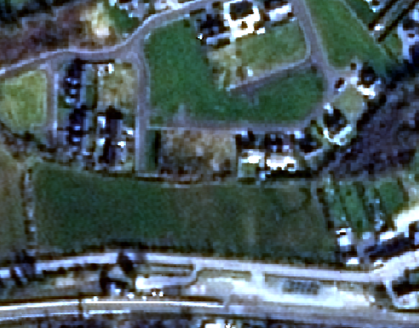
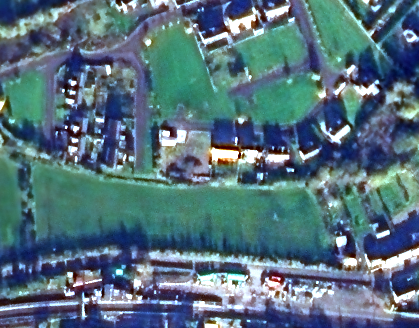
The 26th Mar 2022 satellite photo was described here previously. The new satellite photo was taken on the 10th Nov 2023 clearly showing the much lower sun Ireland gets in the Winter. The detail has somewhat improved, that’s not me that’s skyfi.com delivering better quality than before for the 75 cm resolution image, which is nice to see. The most obvious change is that my neighbour’s house is now there when it was not previously, however you can also make out the lego concrete blocks we laid as described above to the bottom right of my land (yes, they can be seen from space!). The blocks to the left I can’t make out, however the solar panel array is bright white, as is the gravelled section not obscured by the shipping container.
Laying the last of those blocks completed the site preparation part of things, which means all the other preparation stuff now remains, mainly around financing and design. The good news is that eighteen months after application, the mortgage finally came through. So, assuming we can actually get a build going before the mortgage offer expires, that’s the financing portion mostly covered. I say ‘mostly’ because as with any self build the actual problem will be cash flow, or rather, lack of cash flow i.e. the money is there overall, just not where it needs to be at the time needed.
As an example, we have decided to go with Nordan for the glazing. They will need to be paid for that glazing nearly three months in advance of when we will actually need that glazing. That means cash which could be building foundations or walls becomes ‘out of action’ for three months, because it gets locked up with Nordan. There are lots of instances of this, in fact this year’s Single’s Day on Aliexpress I dropped a little over three grand on parts for the house we won’t need for a year, but by buying them now instead of from Irish or European sources a year from now we saved many thousands of euro. They would be cheaper from Aliexpress in any case, but for Single’s Day Aliexpress lops off a further 20%. Hard to argue with that, just need to plan well in advance to take advantage.
As I bought from Aliexpress most of the light fixtures, I needed to make a lighting design to decide what I was going to buy and why. I should stress that this is a foundational lighting design i.e. it’s there to provide the base lighting for a space. It is by no means a final lighting design, or a desirable lighting design – it’s there to provide base illumination for whatever lighting design we end up upon, which is very much to be decided after we move in.
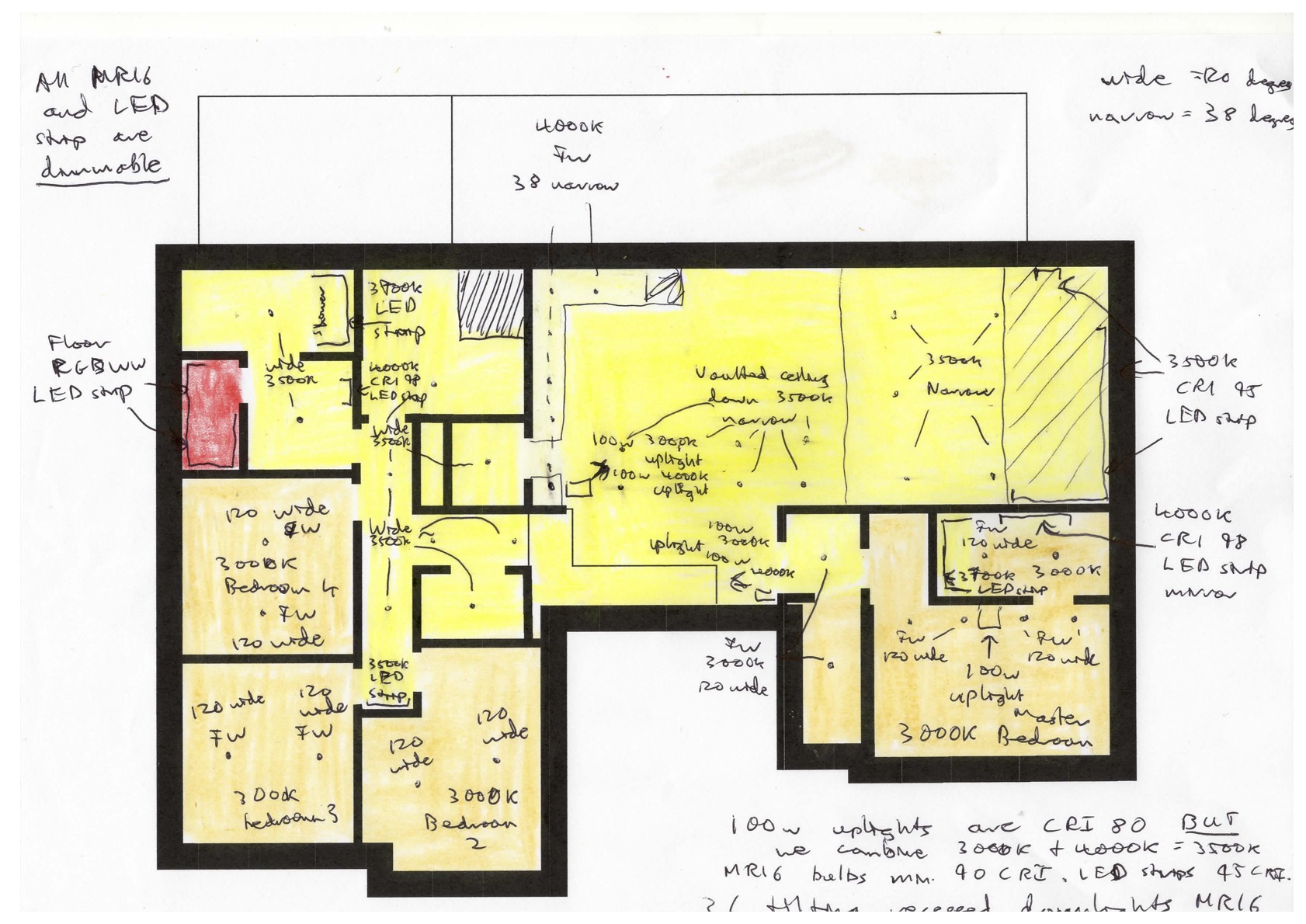
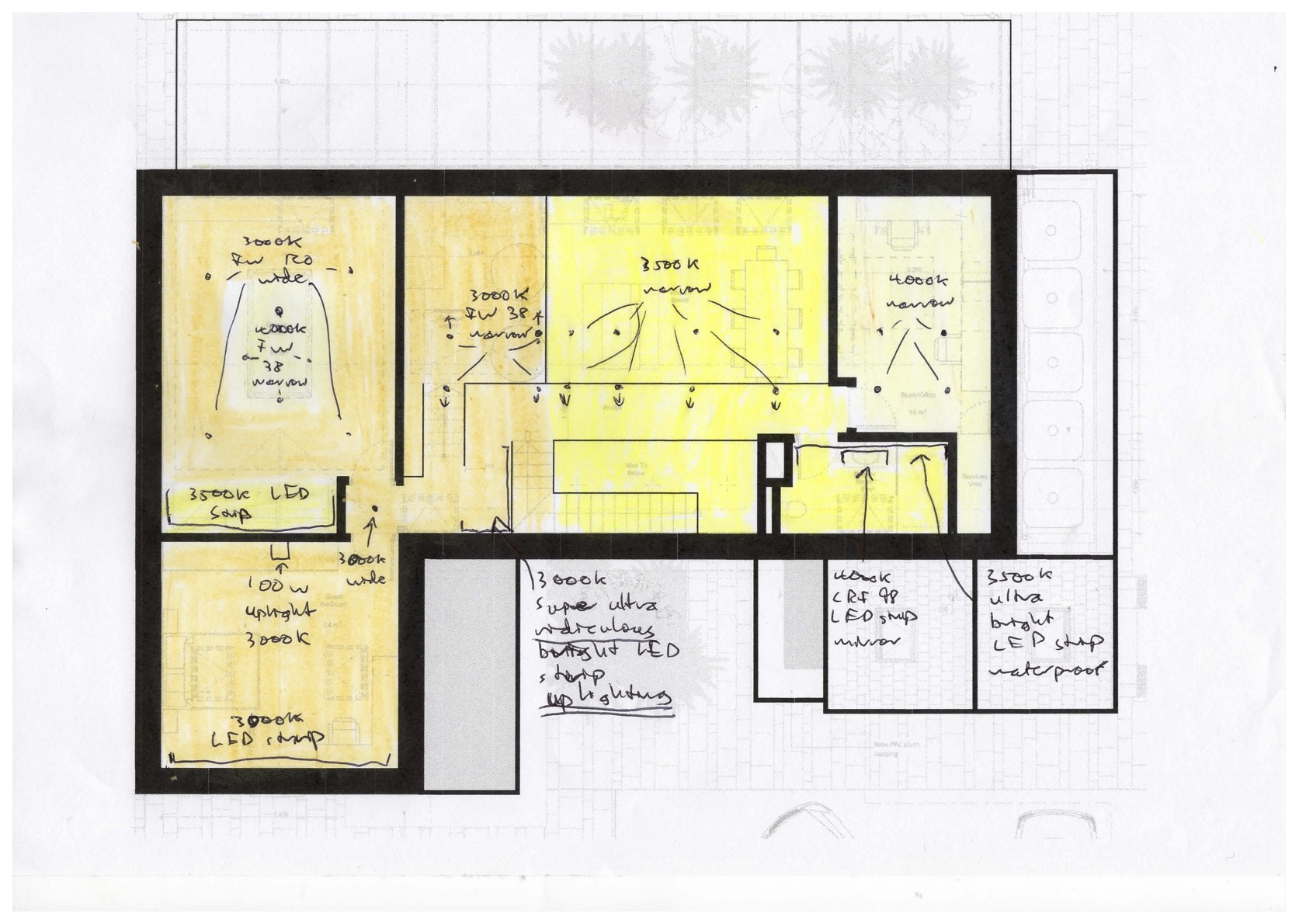
As you will see, there is a mixture of volumetric (i.e. space) and point lighting. These are the base two types of lighting you need in any design (the remaining two are ‘feature lighting’ and ‘accent lighting’ if I remember rightly, it’s been a while). For the space lighting, I have used upward facing industrial floodlights to cheaply and easily light large volumes of vaulted ceiling with a somewhat even base light. Nobody including myself would claim that ideal, but it’s also not a terrible choice either, and the industrial floodlights are cheap and easy and get the box ticked quickly. Point lighting is to ‘top up’ light for specific areas based on use, so for example your kitchen table you will want added light during meals, but not otherwise. So you would have point lights directed at the kitchen table, and you’d switch them on and off as needed. Point lights come in wide (120 degree throw), narrow (40 degree throw), and ultra-narrow – we’ll only be using wide and narrow.
For those point lights, we’ll be using MR16 LED bulbs within recessed tiltable aluminimum ceiling fixtures. Here is one such:
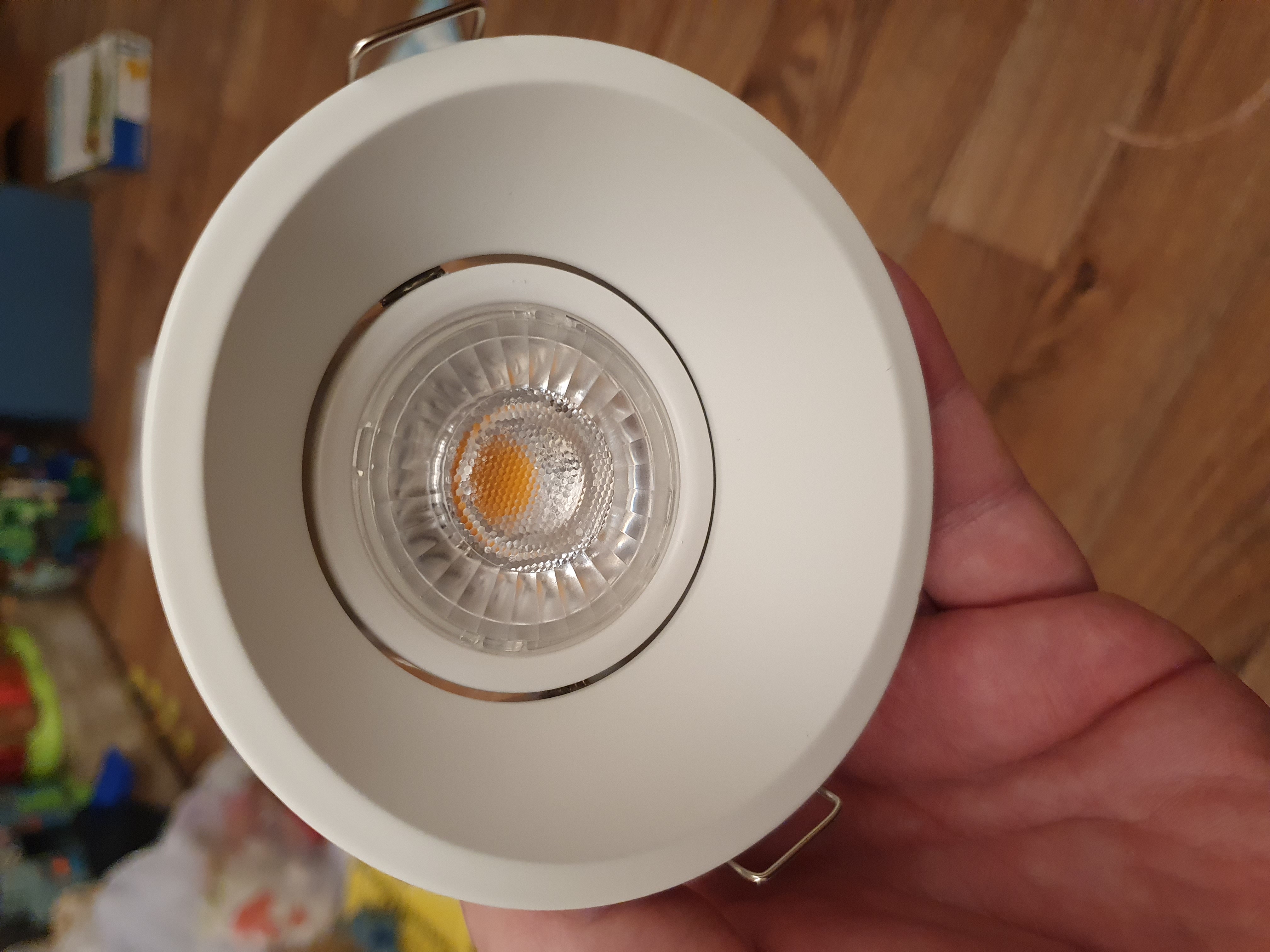
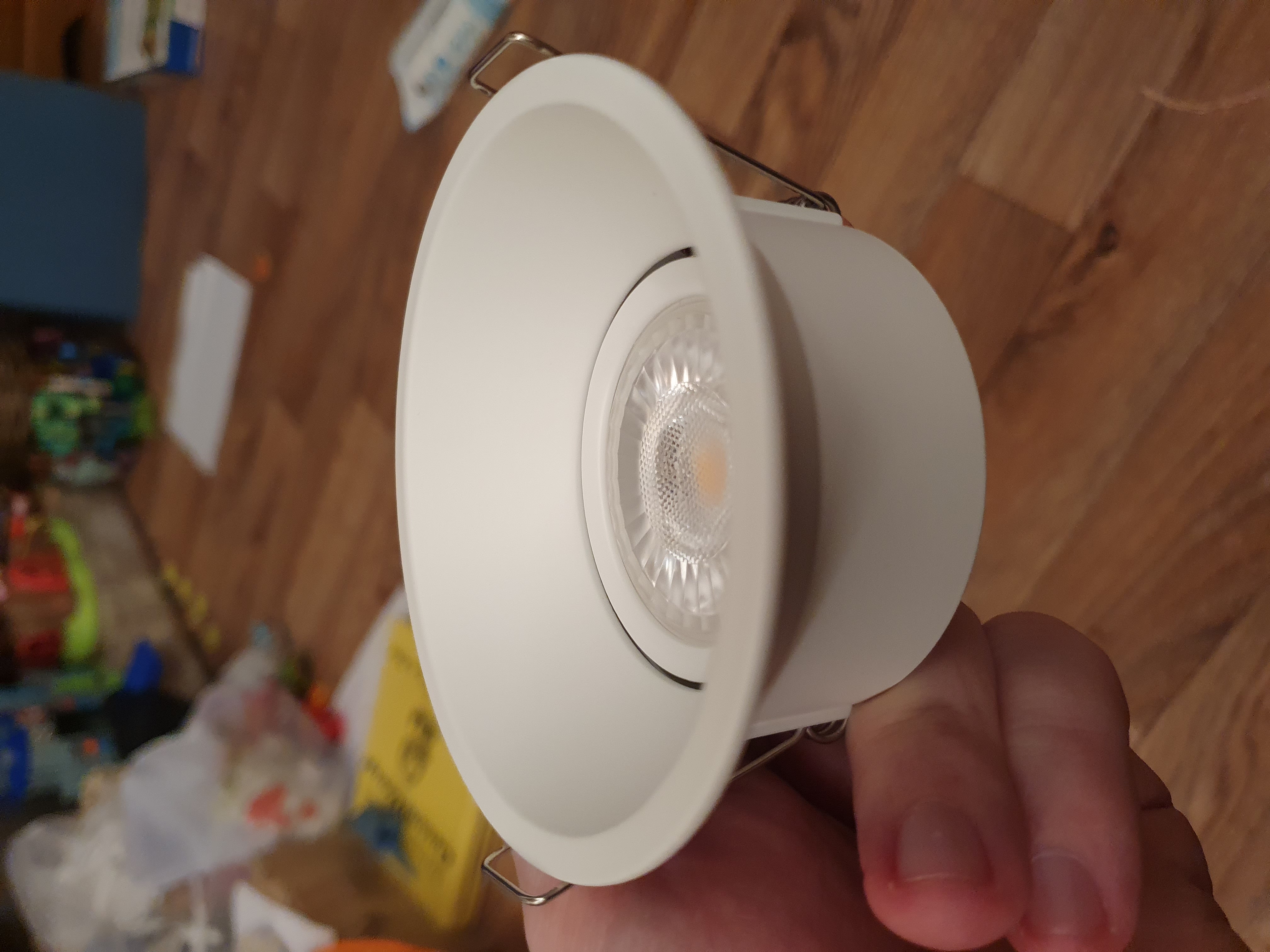
These are a marked step up from the €10/unit cheap and nasty ceiling lights you see in cheaply done home lighting installations, but nobody would claim they are ideal either. They are however cheap, each fixture and bulb is less than five euro, yet the quality of light and fixture will be vastly superior in comparison. For the money I reckon them as good as can be done. The choice of MR16 which is an ancient form of bulb format will seem odd, why use a 12v based light? The reason is because we can drive the lighting from the DC mains, reducing the energy efficiency losses in most home LED lighting from ~40% to ~10%, and swap some of those energy efficiency gains for higher CRI lighting (CRI = Colour Rendering Index, a measure of the quality of the light). Cheap LED lighting like those €10 for a sealed disposable downlight unit mentioned earlier will have a CRI eighty or below, we should average well above ninety throughout the house, and that will be noticeable in how colours and textures and finishings look at night time.
Most European lighting has colour temperatures of < 2700K (very warm white), 3000K (warm white) or 4000K (neutral white) – apart from when somebody fits a 6500K lamp (day light) because they didn’t realise how blue day light looks at lower brightness levels. As you can see above I’ve decided to be difficult and go for these instead:
- 3000K for cosy places like bedrooms, library mezzanine.
- 3500K for main living spaces, bathrooms.
- 4000K for worktops, offices.
It is my belief (and without much proof, to be honest) that 3500K is close enough to 3000K and 4000K that they can be used within the same space without being garish to the eye. The reason I have no proof is that 3500K bulbs are incredibly hard to source, I had to get ours from Amazon US at vast expense during Black Friday. Even with the BF discount, they were very much not cheap. Anyway, I’m looking forward to empirical testing when the bits arrive!
Finally, if you tot up all the lumens all that lighting in the design should emit, you’ll find a typical lumens per sqm (lux) of around 800. This is quite a lot of illumination, most would consider it excessive, putting it another way if all the internal lights are turned on at once the power consumption should be around 1 kW which is a fine amount of power for 100% LED lighting. However nobody would ever turn on all the lighting at maximum power at once – everything is dimmable, there is a fair bit of granularity of lighting control so most lights I would expect to be mostly off most of the time. There is an ulterior motive in fitting so much high wattage bulbs – I know full well they cheap out on the heatsinking because they want bulbs to die frequently so you are constantly replacing them. By speccing all the lights at twice what we need, and then dimming them half or more their power, their heatsinks will better match the power going through them and the bulbs should last a lot longer, plus not suffer from ‘colour fatique’ caused by the LED phosphors slowly burning out from prolonged heat.
Speaking of LED phosphors slowly burning out from prolonged heat, I bought a new TV at a great discount this Black Friday. Here it is playing Starship Troopers:

Yes it is ridiculously far too big for my rented house, and indeed very soon it’s going back into its box because it isn’t stable and I’m scared of the children bringing it down on top of them during their hijinks one day. But I think it’ll do just fine for the wall of my future house, so with a bit of luck by this time next year I’ll be sitting in my new house looking at it on its wall and it will be very reasonably sized for that wall.
The TV is a Philips 65OLED937 which What Hi-Fi? summarised in its review as ‘One of the most all-round spectacular TVs ever made’ (having used it for the past few days, I would concur). Originally retailing at a cool €3,500 in the EU, I got it for €2,300 in the Black Friday sales. Seeing as my ‘new TV’ budget was €1,200 how did I end up spending twice that?
The problem is Ireland and that EU discount retailers will no longer ship TVs to Ireland post-Brexit, so my ruse with the previous TV a Samsung H-series model of buying it from Germany and using the service menu to reconfigure it into a UK-Ireland model and literally saving €450 by doing so was no longer open to me. Believe me on this, I really really tried to repeat that trick – I had been wanting to buy the Philips 55OLED808. In Europe: delivered anywhere in the EU except Ireland, Greece or Malta all in for €1,099. Here in Ireland for the exact same TV: €1,499 with delivery another €75. Fuck that.
It’s like that with TVs for some reason, in Ireland the exact same TV costs at least 50% more in Central Europe, and 100% more is not uncommon. This isn’t new either, back when I bought the Samsung it was the exact same price premium here. The only actual big thing which has changed is eight years ago I could find TVs in the UK at European prices, this year the TVs in the UK even under BF discount had Irish-type price premiums added on top compared to identical models in Europe. Which sucks for the British, but in fairness nothing has got worse here in Ireland – we were always getting price gouged.
Anyway like with most goods different price ranges cause different consumer and vendor behaviours, so you might get one behaviour for TVs under €600, another for TVs €600-€2,500 and still another for TVs > €2,500. I had had a suspicion that this was the case because Philips and other TV manufacturers don’t bother updating their ultra high end every year like with their lower end models. This suggested different release cadences in terms of heavy discounting just before a replacement model launches. The 65OLED937 will be replaced before Christmas with the 65OLED938 – moreover, the 937 is approaching two years old now, so retailers will be especially keen to shift high end clearance stock.
And so it was true: on Cyber Monday, but only that day only, an Irish retailer dropped their price to €2,300 until all remaining stocks cleared. The fellow from their shop who rang me after the sale told me I got the second last one, and the last one sold just after me to a man in Montenotte, Cork. As we were buying a very high end TV (albeit discounted), we got the personal delivery service, and indeed within hours a fellow turned up freshly driven from Dublin with the TV. Obviously this is what it is like to buy > €3k TVs!
So, what do I think of the Philips 65OLED937?
The display is indeed very good. Not quite as good as my Samsung Galaxy S10 phone’s display which remains the best I’ve ever laid eyes upon personally, but no I really could not fault the LG OLED panel in that Philips TV. Colours are rich, bright things are quite bright, dark things are very dark, and lots and lots of detail abounds. If you can feed it high quality 4k input, the display just oozes with detail and contrast. Only if you look really closely and you’re being really critical, the image does have too much white at times. It’s like the white sometimes overwhelms the colour in an unnatural way, and on my phone that never happens. This makes sense: the LG OLED panel has dots purely to add white, whereas the Samsung phone OLED panel does not. Also, the S10’s OLED panel has something like 20% more colour range than the LG OLED panel, and from time to time it is noticeable.
The sound is indeed very good, as every review mentions, and it is easily worth a €1,000 add on soundbar. Which, arguably, makes the TV price actually €1,300 so I only exceeded my budget by €100
 . Again, if fed
high quality input, the audio is clear, balanced, and there is
an attempt to project some space, with only the almost complete
lack of low frequency for some audio kinda glaring. In fairness,
its soundbar’s woofer is no bigger than 1.5 inches, so there
is no point in trying lower frequencies than is physically
possible, and I suspect the cut off is around 100 Hz or so.
I do note a prominent connection for an external
subwoofer of your choice, so clearly the designers intended
if you want proper low frequency audio, you’ll need to add it
yourself. I will admit I was a little disappointed with the
spacial projection of the audio, a MacBook will deliver a
pretty good attempt at 3D surround audio using two speakers. This TV
was nothing like as impressive, though my L-shaped room
probably does not help and in fairness the MacBook’s audio
is class leading.
. Again, if fed
high quality input, the audio is clear, balanced, and there is
an attempt to project some space, with only the almost complete
lack of low frequency for some audio kinda glaring. In fairness,
its soundbar’s woofer is no bigger than 1.5 inches, so there
is no point in trying lower frequencies than is physically
possible, and I suspect the cut off is around 100 Hz or so.
I do note a prominent connection for an external
subwoofer of your choice, so clearly the designers intended
if you want proper low frequency audio, you’ll need to add it
yourself. I will admit I was a little disappointed with the
spacial projection of the audio, a MacBook will deliver a
pretty good attempt at 3D surround audio using two speakers. This TV
was nothing like as impressive, though my L-shaped room
probably does not help and in fairness the MacBook’s audio
is class leading.Android 11 has the least worst audio codec passthrough for Kodi yet. Later Androids are better, but Android 11 which this TV ships with is undoubtedly much less awful than before. I found most Dolby content passes through okay, DTS-MD does not (stuttering) but forcing fallback to DTS Core is a viable workaround. One is still locked into either a 5.1 or 2.0 world here though, Kodi has lots of hacks and workarounds to do either but nothing outside that, and the forcing of content to 5.1 as the only possible surround audio is detectable with this TV as its audio is sufficiently nuanced. At least this removes any thoughts or temptations about a better audio solution in the future, for the vast majority of content 5.1 rendering is what most content will actually render at, no matter its original.
Video codec wise everything I tried to play on Kodi did work fine. Something noticeable was HDR movie content appears to occasionally trigger premature playback end, but Kodi resumes exactly where you left off, and it only happened at most once per movie.
Finally, the OLED display to be honest I’m very glad I went with a heatsinked display like the one in this model. If it isn’t heatsinked, the TV has to back off brightness quickly to prevent pixel burnout. I know from reviews that this particular model has the least aggressive brightness limiter of any LG OLED panel based TV. If that’s the case, I can’t imagine I’d like any of the other LG OLED TVs much at all, I find the brightness backoff a touch distracting and intrusive at times, it actively inteferes with things like scene transitions in a movie. With this TV, it’s okay, I notice it sometimes and that’s annoying, but it’s not too jarring. If other LG OLED TVs are much worse here, and apparently they are, had I bought one of those I would be annoyed.
Oh one last super final point: the TV being new obviously saw a lot of use in its first day or two, and if you have it turned on ‘too long’ it starts to complain at you about it needing to have a period to refresh itself. It’ll get ever increasingly more annoying about this until eventually it just insists i.e. I’m turning off the TV now, I won’t let you turn me on again for at least ten minutes, and whatever you were watching or doing you’re not doing that any more. This only happened once, it never happened any other day so in fairness if it ever gets turned off during a day that seems to placate it. But it did kinda annoy me that it just insisted like that on being turned off.
Obviously the OLED937 is two year old flagship TV, so a bit like with me buying flagship phones two years after release you’re going to be trailing the state of the art somewhat. And that’s okay if the money paid was reasonable.
I don’t pay more than €500 for a phone, and usually more like €400-450. That sets what flagship models are available to me. Until now, I had never paid more than €550 for a television (arguably including playback boxes etc €800) which after inflation all-in might be a grand in today’s money. So it’s been a bit of a leap no doubt.
I don’t know. I don’t regret the purchase per se, it’s a great TV. Did I or the family really need such a nice TV when for half the money there wouldn’t be that much less quality in it? That’s kinda the crunch here, I could get 67-80% of this total package for half the money, even with Irish gouge pricing. There would be cutbacks on so many measures though e.g. viewing angles, this TV has absolutely rock solid viewing angles throughout the L-shape of the rented house. Any non-OLED TV would have substantial colour and gamma distortion instead over such a wide viewing angle. That’s the thing, improvements in multiple areas simultaneously costs money, and as much as heatsinked OLED panels are very much not cheap, they do deliver a display quality across multiple measures simply unachievable with other display technologies (bar maybe Plasma). Even with all their many quirks and annoyances, I suspect I’ll be just fine with the OLED937 in the end.
| Go to previous entry | Go to next entry | Go back to the archive index | Go back to the latest entries |